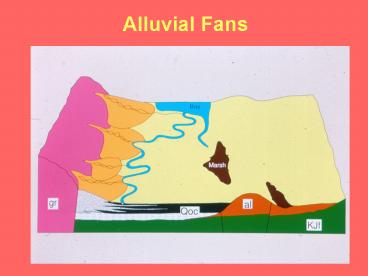Alluvial Fans - PowerPoint PPT Presentation
1 / 17
Title:
Alluvial Fans
Description:
Alluvial Fans Composition: siliciclastic, but all types of clasts are possible (usually compositionally immature) Texture: Immature (close to the sediment source ... – PowerPoint PPT presentation
Number of Views:381
Avg rating:3.0/5.0
Title: Alluvial Fans
1
Alluvial Fans
2
- Composition siliciclastic, but all types of
clasts are possible (usually compositionally
immature)
3
- Texture Immature (close to the sediment source),
poorly sorted, large-sized clasts are common,
clasts can range from angular to rounded
4
- Structures beds with inverse grading, clast
imbrication (with long axes parallel to the
direction of flow or perpendicular to flow)
subhorizontal beds (with normal grading or
poorly-developed grading), rare cross
stratification
5
Geometry of the deposit fan shaped (map view)
wedge or lens (profile view)
6
(No Transcript)
7
Lateral variations rivers, lakes, playas
8
Lateral variations sometimes a series of
alluvial fans form along the edge of a mountain
range (bajada)
Photos taken from satellites
9
Vertical sequence generally, sequences thicken
and coarsen upwardprograding fans
(retrogradational sequences are also possible,
for example, when activity on a fan ceases)
10
Biology bones of terrestrial animals, pieces of
terrestrial plants (but because of the high
oxygen content and the porosity of the sediments,
organic material disappears very rapidly)
Chemical processes sediments often have red or
orange colors because of oxidation of iron
minerals in a subaerial environment soils often
develop on inactive parts of alluvial fans
11
Depositional processes?
12
Depositional processes debris flows, traction
flowssheet flow with rolling and saltating
clasts flow in channels that are shallow and
broad. Alluvial fans may grade downstream into
braided river environments.
Ephemeral flow on fan surface
13
Depositional setting areas with high relief and
steep slopes in tectonically-active regions, arid
to semi-arid climates
14
(No Transcript)
15
The most distinctive characteristics coarse
sediments and debris flows (poor sorting)
16
Rocky Mtns, USA and Canadá
Humid-region fans also found
17
Fan deltas (coarse clasts, like alluvial fans,
but adjacent to ocean or lake) Gulf of
California (Baja México)































